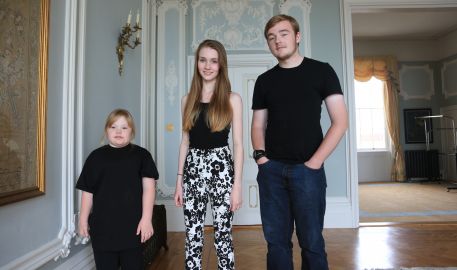Monday – Friday 9am to 5pm
Bracing
Below are the answers to some commonly asked questions about bracing.
Bracing in Scoliosis: Your questions answered
When is bracing used as a treatment?
Braces are mainly used for children and adolescents who have small curves, and are still growing. Patients who have curves between 20˚ and 40˚ during a growth spurt would be the most likely to benefit from bracing.
As well as the rate of growth and the size of the curve, other factors that affect the likelihood of a curve getting worse are:
- How mature the child’s bones are. The more mature the bone, the less likely the curve is to get worse. The specialist can see this from the child’s X-ray.
- The patient’s family history of scoliosis. Recent research suggests that patients with a family history of scoliosis have a higher risk of curve progression.
- Sex of the child. Girls are more likely to have progressive curves, with the ratio of girls to boys increasing with curve size.
How long do you have to wear it for?
Braces should be worn until a patient has stopped growing. Some patients may choose to wear their brace after they have stopped growing. This is not to straighten the spine but can help improve posture and the balance of the spine.
Typically, teenagers wear braces for an average of 26 months, whereas juvenile patients (between 4 and 10 years old) may require brace treatment for many years.
Is bracing effective?
The term ‘effective’ can be interpreted differently. It depends partly on what the patient expects from a brace. Overall, the main aim of any brace is to stop the curve progressing until the patient has stopped growing.
Specialists in the UK have differing views on the effectiveness of bracing. Some recent research from the USA suggests that bracing in children with adolescent idiopathic scoliosis might be effective in controlling curve progression. This means that it can reduce the chance of the curve getting worse.
The research showed that bracing did help to stop some curves from getting worse, preventing some patients from needing surgery. Advice from the Scoliosis Research Society (SRS) says that, although part-time bracing may help small curves, wearing the brace for longer each day is more likely to stop curve progression. Large curves of over 40˚ are unlikely to respond to bracing treatment. SRS also suggests that ‘although the brace cannot make the spine straight, a brace is effective in halting progression in a significant percentage of skeletally immature adolescents’.
In a recent randomised study 91 of 126 (72%) patients who wore a brace managed to control their curve so they did not need surgery. 46 of the 96 (53%) patients who did not wear a brace controlled their curve below the threshold for surgery. The trial was stopped early because the results of bracing were deemed successful. However, it is important to remember that the treatment was more successful if the brace was worn for longer each day.
Also, the study was small and needs to be confirmed in more children. Further, thinking about what happens after a brace is removed is important. Some braces seem to have longer-lasting effects than others.
Some specialists in the UK still question this research so wearing a brace is something that should be discussed with them.
What kinds of brace are there?
There are three main types of brace for treating scoliosis:
Cast braces: Nowadays, cast braces are mainly used to treat infantile idiopathic scoliosis (when scoliosis is first diagnosed between birth and 3 years of age).
Rigid braces: Made of light plastic material, rigid braces use the 3-point pressure treatment principle to limit or stop the progression of the scoliosis. The brace puts pressure at the top of a curve as well as just above and below it using three pads, forming a triangle. Different curves require different pad placements according to curve severity and location.
Rigid braces are worn full-time for 16-24 hours per day (at school, at home, and in bed). Braces in this category are made in plastic that softens when heated so that it can be moulded to a patient’s shape. They include the Boston braces, custom made TLSO braces, and Milwaukee braces.
Non-rigid dynamic braces: These are flexible braces, including the SpineCor brace. Dynamic braces do not use the 3-point pressure treatment principle but use dynamic forces to stabilise a curve. Researchers have developed corrective movements for all types of idiopathic scoliosis and the patient is then braced in that corrective movement and held there by the elastic straps that make up the brace. As the patient goes through the movements of the day, they stretch the elastic straps which then resist and pull them back into the corrective movement.
Which brace is best for my child?
The best brace for a child will depend on the needs of both the child and family. How easy the brace is to wear, how active the child is, how the brace looks, and the psychological effect of the treatment should all be considered. It will also depend on the expertise of the team treating the patient. The Society on Scoliosis Orthopaedic and Rehabilitation Treatment (SOSORT) recommends that ‘each treating team should provide the brace that they know best and are most prepared to manage’.
Why has a certain brace not been offered at my specialist centre?
The brace being offered depends on the expertise of the specialist treating the patient so that the patient’s treatment can be managed in the best way. Some braces will not be offered at your specialist centre because your particular specialist may not have experience in all brace types. Not all specialists agree that bracing is effective so your surgeon may not offer this treatment to their patients.
Will wearing a brace affect schooling?
Wearing a brace should not affect a child at school. However, there may be times when the child needs to see their specialist, brace provider, or physiotherapist. These appointments may be during school time. Sometimes, young people worry about their friends seeing their brace and the effect this will have on their school and social life. This may be something you want to think about when choosing a brace. It is crucial that the patient wears their brace if it is the chosen treatment so picking one that they will wear is important.
Do braces put limitations on what I can do?
Braces should not limit what a patient is able to do, with both rigid and dynamic braces allowing young people to continue playing sport. In fact, if a child is wearing a dynamic brace, there is some evidence that it is more effective if the patient is very active.
In reality, habits may change when wearing a brace. The effect on the patient’s movement may mean that they don’t want to wear their brace as much as is recommended. It is important that they choose a brace that they find comfortable enough to wear for the recommended number of hours per day, otherwise it will not do its job.
Bracing Adolescent Idiopathic Scoliosis (BASIS) study
A £2.5m research study is now open in the UK, looking at the effectiveness of a night-time brace in the treatment of adolescent idiopathic scoliosis. Led by Sheffield Children’s Hospital, the Bracing Adolescent Idiopathic Scoliosis (BASIS) study is currently accepting patients from 22 NHS Trusts across the UK.
The “full-time” brace is the current back brace offered within the NHS, and this is usually prescribed to be worn for 20 hours a day. Although in many patients, it stops the curve reaching a size where surgery would be considered, the brace needs to be worn until growth has finished which is usually several years. It is recognised that this is a very difficult treatment for many young people. The alternative offered as part of the BASIS study, is a new “night-time” brace, which is worn for around 9 hours whilst in bed at night. As this brace works whilst the patient is lying down, it can provide a stronger force to push the curve straighter.
The night-time brace may sound like a more attractive option for patients, but there is currently less evidence to support it’s effectiveness. And this is why the BASIS study is taking place!
At the moment, there are 190 patients* (correct as of 30th August 2023) taking part in BASIS, and roughly half are receiving full time brace treatment, with the other half receiving the night time brace. The study is aiming to involve 780 patients over the next 3 years, and all patients taking part will be followed up in the study until 2 years after they stop brace treatment.
If you’d like to know more about the study, you can visit the BASIS website for further information, and contact details for the coordinating team.
This study is funded by the NIHR Health Technology Assessment (HTA) programme (NIHR131081). The views expressed are those of the author(s) and not necessarily those of the NIHR or the Department of Health and Social Care.30
If you would like to talk further about any aspect of scoliosis, SAUK is here to help; please call our helpline or contact us via post or using our e-mail address info@sauk.org.uk.
© 2024 Scoliosis Support & Research | Scoliosis Support & Research is a registered charity no. 1181463
Website design & development by Pedalo

